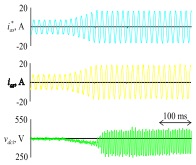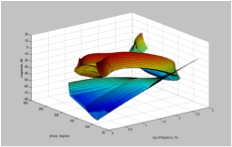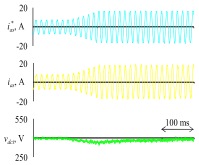Stability of Power Electronics Based Power Distribution Systems
Power electronics based power distribution systems are becoming increasingly prevalent in ships, aircraft, and spacecraft, and have elements which are appearing on the bulk power grid. While power electronics converters offer spectacular performance in terms of regulatory ability, they appear as constant power loads to the systems to which they are connected. As a result of this, if the voltage drops, the currents into these converters increases, so that some power converters look like a negative resistance to the system – which is a destabilizing effect. Over the years, Purdue has worked on many such systems and has developed both tools and methods to help component vendors and system integrators appropriately address this design consideration.
 |
 |
| Immittance Based Stability Analysis of a Generator-Rectifier Inverter-Motor Drive A Indicating Potential Instability | Measured Performance of Drive A Demonstrating Instability |
 |
 |
| Immittance Based Stability Analysis of a Generator-Rectifier Inverter-Motor Drive B Indicating Stability | Measured Performance of Drive B Demonstrating Stable Performance |
One of the most important of Purdue’s contributions in the area of stability analysis is set forth in [1]. This seminal work points out the design implications of various stability criteria, and introduces the ESAC stability criteria which allows great freedom in component designs while still guaranteeing desired gain and phase margins. The paper also introduces, for the first time, the concept of generalized immittance so that stability analysis can be conducted on a system wide basis in one analysis, rather than on an operating point by operating point basis.
While [1] sets forth the basic methodology of immittance based stability analysis in the context of a source load system, it is extended in [2] to the analysis of entire distribution systems in a systematic way. The method the basis of the DC Stability Toolbox. The development of the method and examples are set forth in [3-7]. A new and powerful procedure for calculating immittance is set forth in [8].
Purdue researchers have also investigated large-signal stability using Lyapunov theory. In this case, the stability problem has been posed as an optimization problem which is solved using genetic algorithms in order to determine regions of asymptotic stability [9-11].
In addition to the analysis of and design tools to address stability consideration in dc power systems, Purdue researchers have also developed novel control to mitigate this concern. Some of these methods are described in [12-13].
References
[1] S.D. Sudhoff, S.F. Glover, P.T. Lamm, D.H. Schmucker, D.E. Delisle, “Admittance Space Stability Analysis of Power Electronic Systems,” IEEE Transactions on Aerospace and Electronics Systems, Vol. 36. No. 3. July 2000, pp. 965-973.
[2] S.D. Sudhoff, S.D. Pekarek, S.F. Glover, S.H. Zak, E. Zivi, J.D. Sauer, D.E Delisle, “Stability Analysis of a DC Power Electronics Based Distribution System,” SAE2002 Power Systems Conference (Paper Offer #: 02PSC-17) , October 29-31, 2002, Coral Springs, Florida, USA
[3] S.D. Sudhoff, S.F. Glover, “Modeling Techniques, Stability Analysis, and Design Criteria for DC Power Systems with Experimental Validation,” 1998 SAE Transactions, Journal of Aerospace, Section 1, pp. 52-67
[4] S.D. Sudhoff, D.H. Schmucker, R.A. Youngs, H. J. Hegner, “Stability Analysis of DC Distribution Systems Using Admittance Space Constraints,” Proceedings of The Institute of Marine Engineers All Electric Ship 98, London, September 29-30, 1998.
[5] S.D. Sudhoff, S.F. Glover, “Three Dimensional Stability Analysis of DC Power Electronics Based Systems,” Proceedings of the Power Electronics Specialist Conference, Galway, Ireland, June 19-22, 2000, pp. 101-106.
[6] S.D. Sudhoff et. al., “Control of Zonal DC Distribution Systems: A Stability Perspective,” Sixth IASTED International Multi-Conference On Power and Energy Systems, May 12-15, 2002, Marina del Rey, California, USA
[7] S.D. Sudhoff, S.F. Glover, S.H. Żak, S.D. Pekarek, E.J Zivi, D.Clayton, D.E. Delisle, “Analysis Methodologies for DC Power Distribution Systems,” Thirteenth International Ship Control Systems Symposium, Paper 235, 7-9 April 2003, Orlando, Florida, USA
[8] S. Sudhoff, B. Loop, J. Byoun, A. Cramer, “A New Procedure for Calculating Immittance Characteristics Using Detailed Computer Simulation,” Power Electronic Specialist Conference, Orlanda, FL, June 17-21, 2007
[9] B.P. Loop, S.D. Sudhoff, S. H. Zak, E.L. Zivi, “Estimating Regions of Asymptotic Stability of Power Electronics Systems Using Genetic Algorithms,” accepted for IEEE Transactions on Control Systems Technology. (Final Acceptance in July 2009).
[10] Benjamin Loop, S.D Sudhoff, S.H. Zak, E. Zivi, “An Optimization Approach to Estimating Stability Regions Using Genetic Algorithms,” 2005 American Control Conference, 8-10 June 2005, Portland, Oregon.
[11] S.F. Glover, S.H. Żak, S.D. Sudhoff, E.J. Zivi, “Polytopic Modeling and Lyapunov Stability Analysis of Power Electronics Systems,” SAE2002 Power Systems Conference (Paper Offer #: 02PSC-20) , October 29-31, 2002, Coral Springs, Florida, USA
[12] S.D. Sudhoff, K.A. Corzine, S.F. Glover, H.J. Hegner, and H.N. Robey, “DC Link Stabilized Field Oriented Control of Electric Propulsion Systems,” IEEE Transactions on Energy Conversion, Vol. 13, No. 1, March 1998
[13] S.F. Glover, S.D. Sudhoff, “An Experimentally Validated Nonlinear Stabilizing Control for Power Electronics Based Power Systems,” 1998 SAE Transactions, Journal of Aerospace, Section 1, pp. 68-77.
